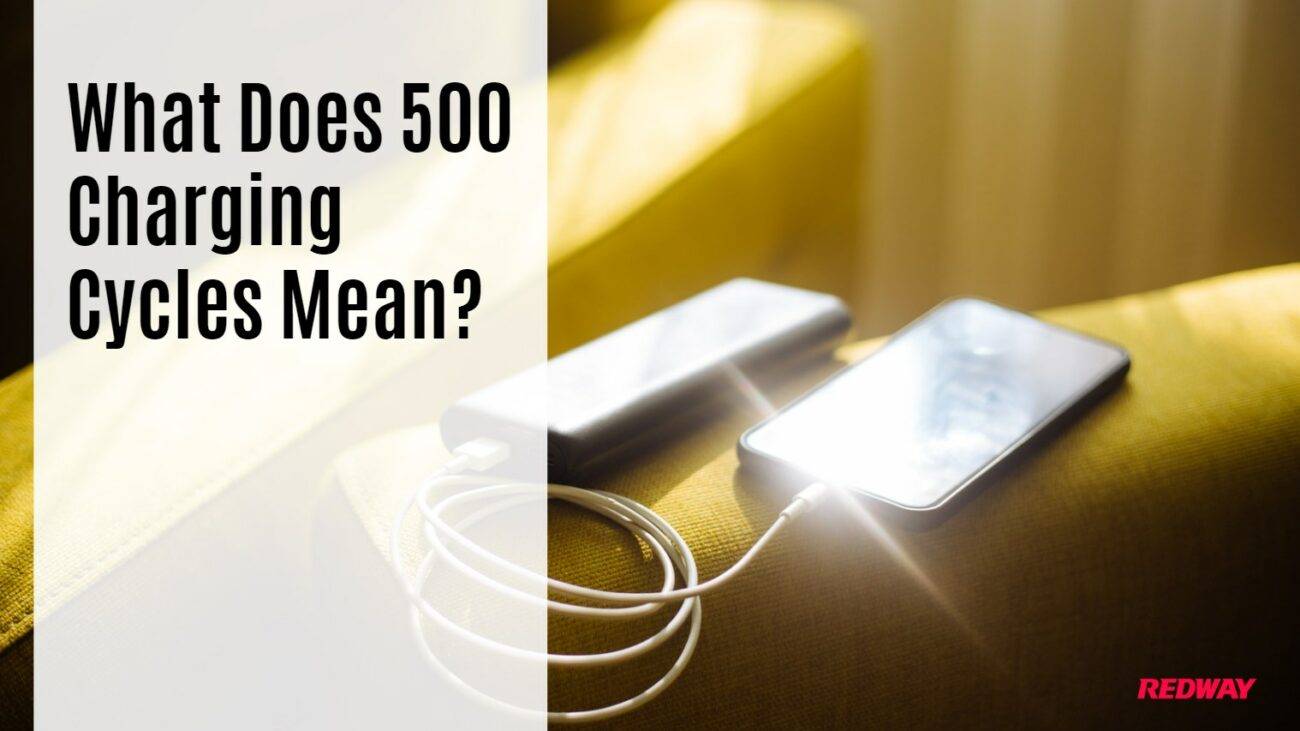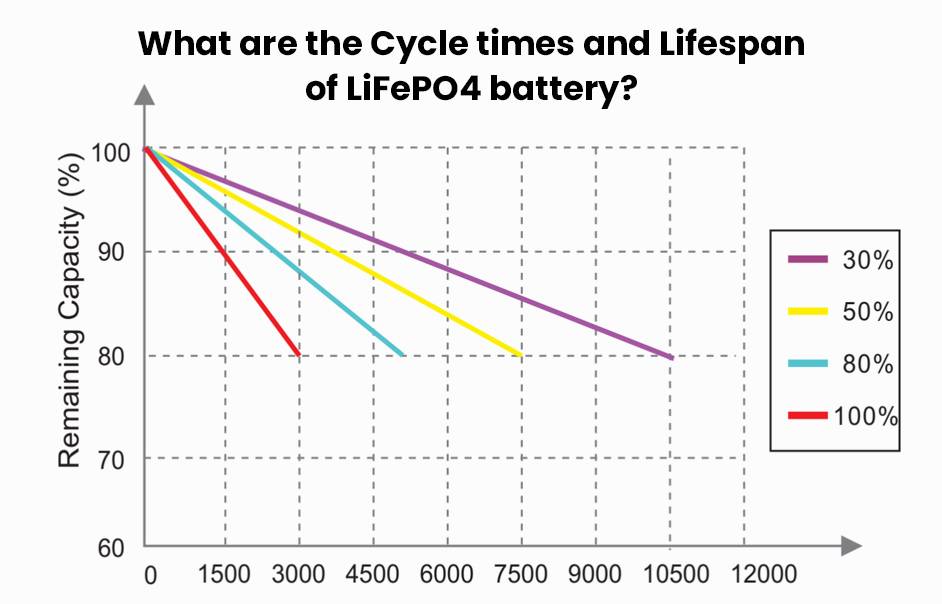Explore the longevity of LiFePO4 batteries in this comprehensive guide, catering to both tech enthusiasts and those seeking efficient device power. Uncover the advantages of LiFePO4 over traditional lead-acid batteries and delve into factors influencing their lifespan. Gain insights into maximizing performance for years to come. Buckle up for a journey of discovery on ensuring the enduring efficiency of LiFePO4 batteries in powering your devices.
Advantages of LiFePO4 Batteries over Traditional Lead-Acid Batteries
How Long Does a LiFePO4 Battery Last?
LiFePO4 batteries boast an impressive lifespan, often lasting 2,000 to 3,000 charge cycles, significantly outperforming standard lithium-ion batteries. Their longevity is due to a stable crystal structure that enhances durability and reliability.
- Longevity: LiFePO4 batteries can endure 2,000 to 3,000 charge cycles.
- Superior Performance: They maintain functionality in high temperatures and under heavy loads.
- Reliability: A stable crystal structure contributes to their extended service life.
What are the charging voltages for LiFePO4 batteries?
Factors Affecting the Lifespan of LiFePO4 Batteries
A. Depth of Discharge
Understanding Depth of Discharge (DoD) is crucial for maximizing LiFePO4 battery lifespan. It refers to the capacity used before recharging and significantly influences overall battery longevity.
- Optimal Performance Range: LiFePO4 batteries perform best when discharged to around 80% of their total capacity. Going beyond this recommended DoD can lead to accelerated degradation and reduced lifespan.
- Avoid Regular Discharges Below 20%: Regularly discharging LiFePO4 batteries below 20% capacity is not advisable. Keeping them above 30-40% charge level for extended periods helps strike a balance between usable energy and preserving overall lifespan.
- Minimize Deep Discharges: Deep discharges below recommended levels should be avoided unless absolutely necessary, as they can negatively impact short-term performance and long-term durability.
- Impact of Frequent Deep Discharges: Frequently deep discharging LiFePO4 batteries significantly reduces the number of cycles they can endure over time, impacting useful life expectancy and potentially requiring more frequent replacement or maintenance.
Conclusion: To maximize LiFePO4 battery lifespan, regular monitoring of state-of-charge and avoiding excessive discharging are essential practices. Following these guidelines ensures extended overall lifespan while benefiting from superior performance capabilities.
B. Temperature
Temperature significantly affects LiFePO4 battery lifespan. Extreme heat or cold can harm performance and longevity, making it crucial to manage temperature conditions for optimal battery function.
- Impact of High Temperatures: High temperatures accelerate chemical reactions, leading to faster degradation and reduced capacity in LiFePO4 batteries. To counteract this, it’s essential to operate within the recommended temperature range of 20-25°C (68-77°F).
- Counteracting High Temperatures: Implement cooling mechanisms or relocate the battery in a cooler environment when exposed to higher temperatures. This ensures the battery operates efficiently and prolongs its lifespan.
- Challenges of Low Temperatures: Extremely low temperatures hinder the battery’s ability to deliver power efficiently. Insulation or heating devices are necessary during freezing conditions to maintain optimal LiFePO4 battery performance.
- Considerations for Temperature Fluctuations: Fluctuations from hot to cold or vice versa can cause thermal stress on LiFePO4 cells, potentially reducing performance. Maintaining a stable operating temperature is vital for maximizing the battery’s life expectancy.
Conclusion: Being mindful of temperature conditions and taking appropriate measures, such as managing heat exposure and addressing cold challenges, ensures optimal performance and an extended lifespan for LiFePO4 batteries.
C. Charging and Discharging Cycles
Charging and discharging cycles significantly impact the lifespan of LiFePO4 batteries. Understanding these cycles is crucial for maximizing battery longevity and reliable power performance.
- Excellent Cycle Life: LiFePO4 batteries outperform traditional lead-acid batteries, enduring thousands of cycles without significant capacity loss. This durability makes them a reliable choice for long-term energy storage.
- Avoiding Extreme Cycling Conditions: While LiFePO4 batteries excel in cycle life, extreme conditions like high discharge rates or deep discharges can still affect longevity. It’s advisable to minimize deep discharges and aim for moderate discharge levels between 20% to 80% state-of-charge.
- Proper Charging Technique: Adopting a proper charging technique aligned with the manufacturer’s recommendations is essential. Overcharging or undercharging can impact the lifespan of LiFePO4 batteries, emphasizing the importance of following guidelines for optimal performance.
Conclusion: By adhering to guidelines that minimize deep discharges, maintaining moderate discharge levels, and adopting proper charging techniques, you can ensure your LiFePO4 battery lasts for many years, consistently delivering reliable power when needed.
Tips for Maximizing the Lifespan of LiFePO4 Batteries
Proper storage and correct charging techniques are vital for maximizing the lifespan and efficiency of LiFePO4 batteries. Following these guidelines ensures optimal performance when you need reliable energy.
- Storage Considerations: When LiFePO4 batteries are not in use, store them in a cool, dry place away from extreme temperatures, humidity, direct sunlight, and heat sources. These precautions prevent negative impacts on battery performance and durability.
- Charging Best Practices: Adopting correct charging techniques is essential. Avoid overcharging or undercharging for extended periods, as this can cause irreversible damage. Use a charger designed specifically for LiFePO4 batteries. Recharge when the battery level is around 20-30% to maintain optimal performance without excessive strain on battery cells.
- Extended Lifespan: By implementing proper storage practices and adhering to correct charging techniques, you can significantly extend the lifespan of LiFePO4 batteries. Taking care of these powerhouses ensures they continue delivering reliable energy for an extended period.
How do I choose which lithium battery to install?
Choosing the right lithium battery for installation involves considering various key factors to ensure optimal performance and safety. Here are important guidelines to help you select the most suitable lithium battery for your specific needs:
1. Voltage and Capacity: Begin by determining the voltage and capacity requirements of your application. Select a lithium battery that aligns with these specifications to ensure it can provide sufficient power for the desired duration.
2. Size and Weight: Consider the size and weight of the battery to ensure it can be conveniently integrated into your system. Choose a battery that fits within the available space and is not overly heavy for your application, ensuring seamless installation.
3. Safety: Prioritize safety by opting for a lithium battery with a proven track record of safety and compliance with industry standards. LiFePO4 batteries are recognized for their safety features and are often considered an excellent choice for applications where safety is paramount.
4. Cycle Life: Evaluate the cycle life of the battery, which indicates how many charge and discharge cycles it can withstand before experiencing capacity degradation. Select a lithium battery with a long cycle life that matches your usage requirements to ensure longevity and reliability.
5. Cost-effectiveness: Balance cost considerations by choosing a lithium battery that offers the best value for your specific needs. Consider the initial investment alongside long-term benefits to determine the most cost-effective option that meets your requirements.
6. Temperature Range: Assess the operating environment of your application to determine the required temperature range for the battery. Select a lithium battery capable of operating effectively in extreme temperatures to ensure stable performance under varying conditions.
7. Brand Reputation and Warranty: Opt for a reputable battery brand known for producing high-quality products. Additionally, carefully review the warranty period and coverage offered to safeguard your investment and provide peace of mind regarding potential issues that may arise.
By following these comprehensive guidelines, you can make an informed decision when selecting a lithium battery for installation that aligns with your specific requirements, ensuring reliable performance and safety in your application.
FAQs
What is the lifespan of a LiFePO4 Battery?
LiFePO4 (lithium iron phosphate) batteries have a long lifespan compared to other types of lithium-ion batteries, typically lasting for thousands of charge-discharge cycles. With proper care and maintenance, they can last anywhere from 10 to 20 years or more.
Can LiFePO4 batteries last 20 years?
While it’s theoretically possible for LiFePO4 batteries to last 20 years or more, their actual lifespan depends on various factors such as usage patterns, charging practices, environmental conditions, and quality of manufacturing. With proper care and maintenance, some LiFePO4 batteries have been known to exceed 20 years of service life.
How can you maximize the life of a LiFePO4 Battery?
To maximize the lifespan of a LiFePO4 battery, consider the following tips:
- Avoid overcharging or over-discharging the battery.
- Use a compatible charger designed for LiFePO4 batteries.
- Keep the battery at moderate temperatures, avoiding extremes of heat or cold.
- Store the battery at a partial state of charge if not in use for extended periods.
- Regularly monitor and maintain the battery’s health and performance.
How do I check the health of my LiFePO4 Battery?
You can check the health of a LiFePO4 battery by monitoring its voltage, capacity, and internal resistance. Some battery management systems (BMS) or chargers may also provide diagnostic information to assess the battery’s condition.
Is it OK to fully discharge a LiFePO4 battery?
While LiFePO4 batteries are more tolerant of deep discharges compared to some other lithium-ion chemistries, it’s generally not recommended to fully discharge them regularly. Deep discharges can accelerate wear and reduce the lifespan of the battery. Instead, aim to maintain a partial state of charge for optimal longevity.
What is the problem with the LiFePO4 battery?
LiFePO4 batteries are known for their stability, safety, and long cycle life. However, some potential issues with LiFePO4 batteries include their relatively lower energy density compared to other lithium-ion chemistries, as well as their higher initial cost.
Should I charge LiFePO4 to 100%?
While LiFePO4 batteries can tolerate being charged to 100% occasionally, it’s not necessary for regular charging. Charging LiFePO4 batteries to around 80% to 90% of their capacity can help prolong their lifespan and reduce stress on the battery cells.
What is the best charging practice for LiFePO4 batteries?
The best charging practice for LiFePO4 batteries is to use a charger specifically designed for them and to avoid overcharging or over-discharging. Charging LiFePO4 batteries to around 80% to 90% of their capacity and avoiding extreme temperatures can help optimize their performance and longevity.
Should LiFePO4 be stored fully charged?
It’s generally not recommended to store LiFePO4 batteries fully charged for extended periods, as this can accelerate degradation and reduce their lifespan. Instead, store LiFePO4 batteries at a partial state of charge (around 40% to 60%) in a cool, dry place if they won’t be used for an extended period.
What is an inverter and will I need one?
An inverter is a device that converts direct current (DC) electricity into alternating current (AC) electricity. If you wish to utilize the electricity generated by a battery or a solar panel to operate devices or appliances that are designed for AC electricity, then you will need an inverter to facilitate the conversion process. It essentially allows you to transform the DC power produced by sources like batteries or solar panels into the AC power that most household devices rely on for operation.
Will installing a lithium battery affect my vehicle or boat’s warranty?
Whether installing a lithium battery will have an impact on your vehicle or boat’s warranty depends on the warranty policy set by the manufacturer. It is crucial to carefully review the terms of your warranty to determine if there are any restrictions related to lithium batteries. Some manufacturers may void the warranty if a lithium battery is installed without their prior authorization, while others may not have specific limitations regarding lithium batteries.
To ensure that your warranty remains intact, it is recommended to consult with the manufacturer before proceeding with the installation of a lithium battery. Professional installation is essential to prevent any potential issues or damages. The installation process should adhere to the manufacturer’s guidelines and recommendations, as well as industry standards, to maintain the safety and integrity of the battery, the vehicle or boat, and the electrical system.
Properly sizing, matching, and installing the lithium battery according to the manufacturer’s specifications and industry standards is crucial to prevent damage and safety hazards. In summary, the impact of installing a lithium battery on your vehicle or boat’s warranty will depend on the manufacturer’s warranty terms, and it is advisable to seek clarification and follow professional installation procedures to avoid any warranty-related issues.
What is the 40-80 battery rule and how does it impact battery lifespan?
The 40-80 battery rule advises maintaining the State of Charge of a battery within the range of 40% to 80%. This entails recharging the battery when it drops to around 40% and disconnecting the charger once it reaches the 80% mark. Adhering to this rule is believed to positively impact the lifespan of the battery by helping to manage the charge level within an optimal range.
How to Calculate the LiFePO4 Battery Cycle Life?
Calculating the cycle life of a LiFePO4 battery is not a straightforward task due to the various factors that influence its longevity. However, you can estimate the cycle life by first determining the battery’s watt-hour capacity. To find the watt hours, multiply the Ampere hour (Ah) capacity of the battery by its rated voltage. For example, for a 100 Ah battery with a voltage rating of 12V, the watt hours would be 100 Ah x 12V = 1200 Wh.
Once you have the watt-hour capacity, you can further refine this calculation by multiplying it by the Depth of Discharge (DoD). The DoD represents the percentage of the battery’s capacity that can be discharged before it needs to be recharged. Assuming a DoD of 80%, the usable watt hours would be 0.8 x 1200 Wh = 960 Wh.
Determining the battery runtime involves dividing the usable watt hours by the load applied to the battery. For instance, if you are powering a TV with a load of 100 Watts, you would calculate the runtime by dividing 960 Wh by 100 W, resulting in 9.6 hours of continuous runtime.
While this calculation provides an estimate of the battery’s runtime based on its watt-hour capacity and the applied load, it’s important to note that accurately predicting the precise cycle life of a LiFePO4 battery involves considering additional factors that can affect its overall longevity.
How many cycles can a good lithium battery, specifically LiFePO4, last for?
LiFePO4 (lithium iron phosphate) batteries have a long lifespan compared to other types of lithium-ion batteries, typically lasting for thousands of charge-discharge cycles. With proper care and maintenance, they can last anywhere from 10 to 20 years or more. Good lithium batteries can last for more than 5000 cycles, specifically those utilizing the Lithium Iron Phosphate (LiFePO4) technologies. This technology surpasses conventional nickel or manganese-based lithium batteries, which typically last for only around 2000 cycles.
How Many Cycles Do LiFePO4 Last?
LiFePO4 (lithium iron phosphate) batteries have a long lifespan compared to other types of lithium-ion batteries, typically lasting for thousands of charge-discharge cycles. With proper care and maintenance, they can last anywhere from 10 to 20 years or more. It’s important to note that the cycle life of LiFePO4 batteries can vary based on several factors, such as how they are used, stored, and the manufacturing quality. Users may experience different cycle life outcomes even with batteries from the same brand. Additionally, while some manufacturers claim batteries can last up to 20,000 cycles if maintained as recommended, actual performance may differ. Understanding these nuances can help users make informed decisions about their battery usage and expectations.













